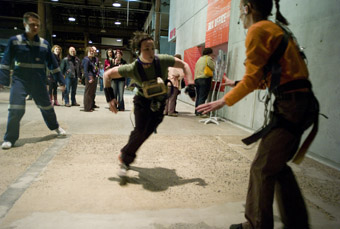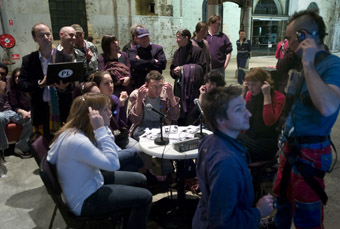a game with the works
gail priest lives vicariously through wayfarer

(foreground l-r) Martyn Coutts, Kate Sherman, Sharon Kerr, Wayfarer
photo Marco Bok
(foreground l-r) Martyn Coutts, Kate Sherman, Sharon Kerr, Wayfarer
GAMES BORE ME. MONOPOLY, SCRABBLE AND SNAKES & LADDERS WERE NEVER 3D ENOUGH. COMPUTER GAMES SEEM LIKE A RUSE: A FANTASY OF AGENCY WHEN IN FACT YOU’RE JUST A PAWN IN THE CONSTRUCT, ABLE TO BE BRUTALLY GUNNED DOWN AT ANY MOMENT. (OKAY, I’M NOT THAT GOOD AT THEM EITHER.) SO I WAS INTRIGUED YET TREPIDATIOUS ABOUT KATE RICHARDS AND MARTYN COUTTS’ WAYFARER, A LIVE, SITE-SPECIFIC, PERFORMATIVE GAME AT PERFORMANCE SPACE. BEING SLOW TO BOOK I WAS NOT ABLE TO BE AN ACTIVE PARTICIPANT BUT, THANKS TO THE MIGHTY ORANGE TEAM, ALLOWED TO HITCH A RIDE.
The first thing I notice is that Wayfarer is no mean technical feat. CarriageWorks is infested with multiple wireless networks allowing two-way audio communication between performers and audience, multiple live point-of-view camera feeds and complex positional tracking. Yet the human remains very much at the forefront of the activity, from the performer and player interaction before and during the game to the roving technicians ready with laptops to solve any little stagefright issues the technology might experience.
The rules of the game are kept simple: the audience teams of four have to direct their performer/player (wayfarer) to run around the cavernous CarriageWorks complex looking for triggerpoints which they swipe, seemingly by pointing at them. This gives the team “loot” and an instruction which they must then get the performer to act on. The instructions are minimal but involve interactivity between players or between players and unsuspecting bystanders: for example, “Follow another wayfarer for two minutes”, “Get 10 cents from a stranger” (the orange team managed to get 50 cents), or “Work with another wayfarer to reach the target.” The most alarming option is the “licence to kill” where one of the wayfarers gets the green light to hunt down the others and steal all their loot. It was not totally clear what this ‘murder’ entailed, and I’m pretty sure no lives were lost in our game, however the non-contact battle posturing between players was certainly amusing.

audience players, Wayfarer
photo Marco Bok
audience players, Wayfarer
The use of simple tasks and basic rules means that the strength of the game is in the quality of the interactions: between the performers, between performers and audience, and between audience members. The collective fulfilment of tasks means that the relationship between performer and audience is equal, making the interactions strong, direct and meaningful. The group dynamics of audience-players in their teams is particularly interesting to watch (the benefit of being an observer): who takes the lead, who is the problem solver, who has the most competitive drive? My favourite moment came when one of the members of the orange team who had rarely spoken very politely suggested, “We have six minutes left so if you could just take it up to a quick jog…” And let me say that the green team who won were just a little bit aggressive for my liking!
The most engaging aspect of Wayfarer is the integration of the live performers into the game, and the interplay with CarriageWorks itself. Early in the game, amidst a foyer full of theatregoers there are sudden squeals and shouts as the players tear through the space trying to catch each other. This moment is electrifying, forcing the audience-players to exist in simultaneous states of reality and virtuality which is pleasantly disorienting and even a little bit magical. The performers also return to base or come into visual range, but more of their live interaction in the real world would strengthen Wayfarer. Interestingly some audience members would have been more familiar with the building than others and I wonder how this affected their game. Knowing the space well I found that the activity of correlating real and virtual spatial information added another satisfying dimension. Either way, the audience-players and those living vicariously seemed to find Wayfarer engaging as both game and performance and I eagerly await the next manifestation to make myself part of the action.
performing objects & machines
Wayfarer was not the only activity infiltrating every nook and cranny of CarriageWorks on the final night of Performance Space’s July-August programming. The contraptions created by participants in Joey Ruigrok van der Werven’s Performing Objects and Machines workshop were also let loose on the foyer giving us a taste of the potential of a new generation of makers and theatre magicians. Many people felt that Tobhiyah Stone Feller’s elegantly simple Track Temptation—five segments of railway track suspended end to end, activated like a pendulum allowing them to gently clang—should be permanently installed and used as the interval bell.
Sarah Firth-Smith’s Emerging Artist—a wet-black, mutant tree whose squirming arms drew pictures wherever they made contact with the ground—had a creepy yet strangely endearing autonomous presence. Pongpassakorn Kulthirathum’s mobile audiovisual locomotive was ingenious in its self-contained efficiency; Marley Dawson interacted with and activated some of the heritage machinery left in the rafters; Michelle Outram generated electricity by playing the piano via a pully system; Kat Barron took 3D photos in a pyramid; Agatha Gothe-Snape went lo-fi, activating her paintings with cables and magic bells; and Clare Britton mutated like a Transformer into a giant mobile chook!
making the space work
All this activity, along with the Wayfarer team screaming past and the capacity audience from Version 1.0’s Deeply Offensive and Utterly Untrue pouring out, brought the CarriageWorks foyer absolutely to life. This vibrancy has also been present at events like Performance Space’s Night Time series (RT78, p38) and the recent Underbelly festival (co-produced by CarriageWorks, RT80, p44). But I can’t help comparing the joy of all this with the unease of the opening night of the July-August season when the theatre audience was overwhelmed by a massive department store fashion parade at the other end of the foyer. Of course there are understandable financial pressures on the CarriageWorks management to generate income, but the only way the venue will succeed culturally and develop an audience is by consistently filling its spaces with the stuff that it was actually built for—smart, challenging, bold and intriguing art.
For an interview with Kate Richards about Wayfarer, see RT80, p4. For another Performance Space event in the CarriageWorks foyer directed by Joey Ruigrok van der Werven, see Volta on November 24, 25.
Wayfarer, artists-producers Kate Richards, Martyn Coutts, technical producer-designer Mr Snow, House of Laudanum, programmer-software designer Jon Drummond, Squelch Media, performers Kate Sherman, Sharon Kerr, Ben DeMole, Ryk Goddard, wayfarer unit design Marty Jay, Steve Howarth, erth, screen design Tim Richter, SV2; Performance Space at CarriageWorks Sept 5-8; Performing Objects and Machines, facilitating artist Joey Ruigrok van der Werven; Performance Space at CarriageWorks Sept 8
RealTime issue #81 Oct-Nov 2007 pg. 35






